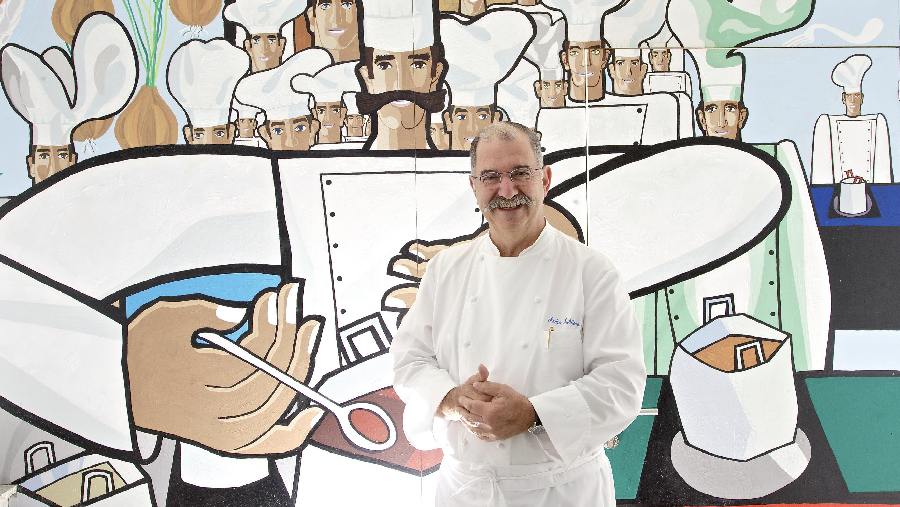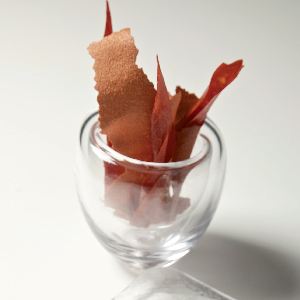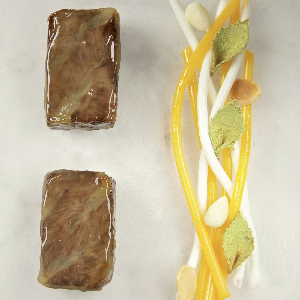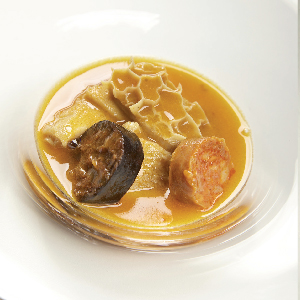Pedro Subijana was one of the founders of the New Basque Cuisine movement together with Juan Mari Arzak; a movement that changed gastronomy across the world. Born in San Sebastian and destined to become a doctor, Pedro opened a restaurant in 1975. At first, it was a traditional grill restaurant in Tolosi. This then became a restaurant at a sports club, and at that point in time, no one ever expected him to be awarded three stars. Yet in 2007, he was. Pedro Subijana’s cooking pays great attention to detail yet ensures primarily, that each and every evening is filled with culinary fun and entertainment. He is an avid supporter of the four seasons, and changes his menu regularly. Does he include veal in his menus? Of course! “In this region, we traditionally eat more beef than we do veal. I work mainly with the tripas, the byproducts, but I like to combine them with prime cuts. People here don’t like white veal, so we use veal that is pink or red in colour, but that is just as delicate as white meat. We do not fry this meat for the same length of time as we do our beef. My guests know that it should be eaten pink.”
Toss the pieces of calf’s tail in flour and fry in some oil until nicely golden. Add the sliced vegetables for a few minutes and then deglaze with cognac and red wine. Reduce down before adding the veal jus, and then cover the pan with a lid and seal tightly with bread dough. Cook in the oven for 6 hours at 110°C/230°F, cool and then pull the meat apart. Strain off the liquid using a sieve and thicken with corn starch. Mix the meat with the thickened jus, pour onto a baking sheet to a depth of 5 mm and allow to set in the fridge. For the tartlet, whisk the egg with the lacticol, add the rest of the ingredients, and pour onto another baking sheet that has been lined with a silicon mat, to a depth of 5 mm. Bake in the oven for 14 minutes at 150°C/300°F. For the liver, dissolve it in hot water and add the soaked gelatin. Blend until smooth and pour onto a third baking sheet to a depth of 5 mm. Put the base for the tartlet on a tray, place the tail meat on top, and cover it with the liver. Sprinkle with the cocoa powder and cut into rectangles. For the puree, crush the chestnuts and put them in the boiling milk and mix until smooth. Season to taste. Peel the rest of the chestnuts, slice ultrathinly on a mandoline, and deep-fry in olive oil until golden brown. Pan fry the veal tenderloin in a knob of butter to the desired level, and allow it to rest, but keep it warm. Cut the tenderloin in half and serve on a plate with the puree. Place a tartlet next to it and season the meat with the fried chestnuts and the Anãna salt. Serve with paprika flakes.
Serves 4
Veal tenderloin (2 portions of 150g each), butter, veal jus, Anãna salt flakes, paprika flakes.
For the calf’s tail
500g calf’s tail (chopped), 100g red wine, cognac, 100g onion, 100g leek, 100g carrot, 1 bouquet garni, 1l veal jus, 50g bread dough, flour and corn starch.
For the tartlet
1 egg, 33g lacticol, 25g milk, 30g olive oil, 35g flour, 1g yeast, 12g almond flour.
For the liver
100g duck foie gras (semi-cooked and rubbed through a sieve), 100ml water, 1 gelatin leaf, 5g cocoa powder.
For the chestnut puree
100g boiled chestnuts, 50g milk.
For the deep-fried chestnuts
4 chestnuts, olive oil.
Die Kalbswangen säubern, 2 Stunden bei schwacher Hitze in der Bouillon garen und in der eigenen Flüssigkeit aClean the veal cheeks and simmer in the bouillon for about 2 hours on a low heat. Then leave it cool in the liquid. For the sauce, re-heat the liquid and thicken with the vegetable gelatin. Add some pepper and set to one side. For the apple leaves, cut an apple into very thin slices using a slicing machine. Shape them into leaves and marinate for 6 hours in the syrup. Put the leaves on a silicon mat and bake in the oven for 15 minutes at 150°C/300°F. If necessary, mould the leaves again and toss them in the tea powder. For the first spaghetti, mix the egg yolk with the salt. Using a syringe, fill straws with the mixture and steam for 3 minutes in a steamer at 85°C/185°F. Take the spaghetti out of the straws and keep to one side. For the other spaghetti, sweat the garlic in some olive oil, add the rest of the oil, sieve and cool. Blend the egg white with the oil as if you were making mayonnaise and use a syringe to fill more straws. Steam for 4.5 minutes in a steamer at 85°C/185°F, cool slightly and remove the straws. Cut the veal cheeks into rectangles, brown on the plancha and glaze with the thickened sauce. Put two of the rectangles on a plate and place the apple julienne, both kinds of spaghetti, the apple leaves and the toasted almonds next to them.
Serves 4
2 veal cheeks, 1l veal bouillon, apple julienne, toasted almonds.
For the sauce
100g of the liquid from the veal cheeks, 7g vegetable gelatin, 1g ground black pepper.
For the apple leaves
1 Granny Smith apple, 100g sugar water 1:1, 20g green tea powder.
For the egg yolk spaghetti
50g egg yolk, salt.
For the egg white spaghetti
25g egg white, 75g olive oil, 5g garlic.
Mix the vinegar with the flour and sea salt, and pour over the tripe. Rub in well and rinse a few times with fresh water. For the bouillon, bring a sufficient amount of water with the rest of the ingredients to the boil. Simmer for a while and then add the nose and the shank. Simmer slowly, constantly skimming off the foam. Then add the tripe. Simmer for 2 hours on a low heat and leave to cool in the liquid. Trim the tripe well and chop the nose and shank meat into a brunoise. Pass the bouillon through a fine-mesh sieve and put to one side. For the sauce, sweat the finely-chopped onion in oil, add the chorizo and the blood sausage and fry it all together well. Add the garlic and the ham and allow it to sweat again. Allow it to cool slightly before removing the chorizo and the blood sausage. Put these to one side. Add both kinds of paprika powder and the pimento. Bring to the boil and add the tomatoes. Gradually add more and more of the sieved bouillon to thicken the sauce and simmer gently for 15 minutes. Pass this through a fine-mesh sieve, add the tripe and season to taste with pimento. Spoon the brunoise of the shank and nose through the sauce and simmer slightly so everything is covered with sauce. Spoon into a dish with the chorizo and the blood sausage.
Serves 4
1kg veal tripe, 1 veal nose, 1 veal shank, 310g chorizo, 310g blood sausage, 1 dstspn flour, 2 dstspn vinegar, 50g coarse sea salt.
For the bouillon
1 pimento, 1 onion (pierced with 2 cloves), 2 cloves of garlic, 1 carrot, 1 leek, black pepper, lovage, 2 juniper berries, 1 bay leaf, coarse sea salt.
For the sauce
50ml olive oil, 1 onion, 1 clove of garlic, 50g ham, 1 piece of dried pimento, 100g flour, 10g mild paprika powder, 3g hot paprika powder, 100g ripe tomatoes.



